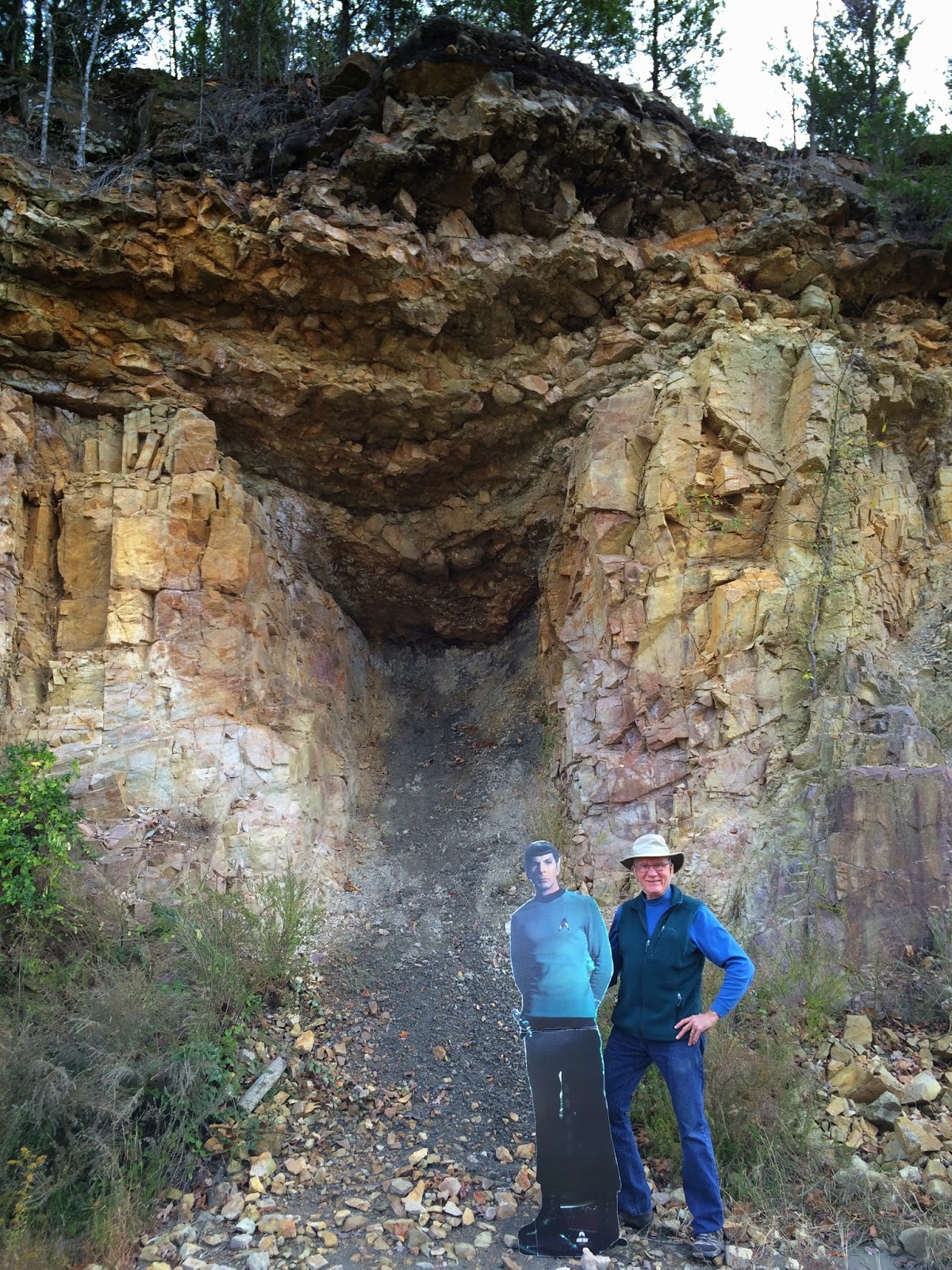On the way to the first geo-site we passed through this town. We pass lots of places that have "dale" in their name, so when we saw an entire town devoted to "Frederick", we had to stop and take this picture.
Elephant Rocks were our first stop. Granite blocks below an ancient mountain chain were exposed and the myriad forces of weathering attacked the exhumed granite which became a classic tor -- an isolated pinnacle of much-jointed granitic rock that, through exposure to intense weathering, assumes eccentric or fantastic shapes. The corners and edges of the exposed granite blocks decompose faster than the flat surfaces, becoming rounded and geometrically muted in a process known as spheroidal weathering.
Mr. Spock marveling at "Dumbo", standing atop a granite outcrop, one of the largest elephant rocks, topping the scales at a whopping 680 tons.
Spock, using his imagination, imagined these end-to-end row of giant boulders appearing to be a trunk-to-tail assemblage of trained circus elephants.
Charming rocks in a spectacular setting.
While we were at Elephant Rocks State Park, we learned that, just down the road, there had been a recent enactment (September 26 - 28) of a major Civil War battle in Missouri, at Pilot Knob. The town of Pilot Knob occupied a strategic position and Federal troops had built an earthen-works fort with a large ammunition storage in the center. In September 1864, Confederate Maj. Gen. Sterling Price led the largest Confederate cavalry raid of the war into Missouri. Objectives of Price's Raid were to gather Confederate recruits, capture and destroy Union war materials and if possible, capture St.Louis or Jefferson City.
En route to the St. Louis area, Price decided to attack the weakly defended Fort Davidson at Pilot Knob. When word of the possible attack reached Union forces, Gen. Thomas Ewing was sent to help defend the fort, bringing the Union forces to approximately 1,500 troops.
On September 27, an 8,000-man Confederate force attacked the fort in a series of infantry assaults. Poor timing of the assaults allowed heavy fire from the garrison to be directed at each attacking brigade. Only one Confederate brigade reached the fort. It advanced across the open plain under murderous fire, halting only when it reached the fort's moat, where the Union soldiers threw hand grenades down on them. The assault was broken. The 20-minute battle resulted in 1,000 Confederate troops killed or wounded, while the Union force suffered less than 100 injured or killed. The Confederate forces fell back to reorganize and prepare for a renewed attack the next day.
Union Gen. Ewing, low on ammunition for his cannons, knew his forces could not hold out a second day and he ordered the evacuation of Fort Davidson. Under cover of darkness in the early morning hours, soldiers silently exited the fort, taking a couple of cannons with them. They marched past Price's men, who mistook them for their own men. A small group of soldiers were left behind long enough to blow up the powder magazine.
We decided to visit the site and stopped at the Battle of Pilot Knob State Historic Site.
Inside the Visitor Center was this relief map of the valley and Fort Davidson (the white hexagonal shape in the middle).
These earthen works are all that remain of the Fort.
This crater marks the site of the powder magazine inside the Fort, which held some 20 tons of gunpowder and ammunition during the battle. At midnight, the Union troops silently evacuated the fort. They piled equipment they could not take against the magazine and an hour later a party of volunteers lit a fuse to the magazine and galloped for safety.
Frederick by the cannons.
Pilot Knob above the Visitor Center.
1,480 million years ago, a volcanic eruption produced an ash flow that cooled an crystallized into a rock known as ignimbrite. Magma intruded the fractures 150 million years later forming a 5-foot wide dike. The road cut we visited shows the weathered result.
On the north side of the road, Missouri 72, Mr. Spock notes that the dike weathered to a deeper degree than the ignimbrite.
The south side of #72 shows that a coarse mantle of debris rounded by a shallow sea 500 million years ago created a layer of conglomerate. This conglomerate sagged into the eroded dike and is now in contact with the ignimbrite creating a nonconformity.












That Spock is a wealth of Geo-knowledge
ReplyDeleteThat's one Civil War battle of which I was totally unfamiliar. I'm currently reading Liar ,Temptress, Soldier, Spy by Karen Abbott, about women spies during the Civil War, so your blog was of special interest and very timely!
ReplyDeleteI love the "Fredericktown" one! Frederick, I bet you didn't know you had a town named after you!
ReplyDelete